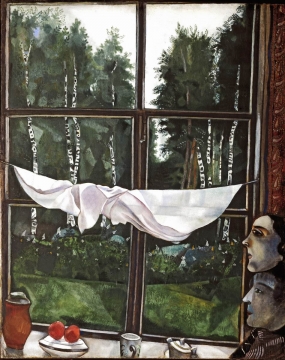Through the Window - Part 1: Looking into the World
Rebecca Spears
 Outside my kitchen window, a gingko tree
bursts gold, fan-shaped leaves shimmering
in fresh air. I have thought all morning
about what I want, and it’s nothing.
—Elizabeth Drewry, “Nothing Is Wanting”
Outside my kitchen window, a gingko tree
bursts gold, fan-shaped leaves shimmering
in fresh air. I have thought all morning
about what I want, and it’s nothing.
—Elizabeth Drewry, “Nothing Is Wanting”
I have a wall of windows in my classroom, and I keep the blinds wide open unless I am using media that requires a darkened room. As soon as the media presentation is over, I let the blinds blink open so that daylight can flood the room again.
Recently, I’d been exploring my penchant for light when I came across Charles Hebermann’s entry in the Catholic Encyclopedia on “Windows in Church Architecture.” He has this to say about church windows, especially for people who are accustomed to a whole lot of light: “The temperament of the people of the East and the South where Christian houses of worship first appeared, required the admission of much light by large openings in the walls.”
In an earlier post, “How the Light Gets In,” I wrote about the plain church style of using clear-paned glass and how much this style appealed to me, not only in churches but in just about every other structure. I’ve lived in the American Southwest most of my life where bright days are a force of nature all on their own. I love the light.
Windows are also essential to connect to the larger world, and as Michael Pollan notes in A Place of My Own, windows frame the landscape and let us interpret it. Looking into the landscape, we not only reflect on it, but it leads us to consider our lives and work.
Outside my classroom windows, my students and I have seen coyote, deer, rabbits, plenty of squirrels, and too many birds to name them all—great blue heron, egrets, carrion crows, red-tailed hawk, mourning dove, and robins. We’ve also watched other students working on large art projects, like sculptures and murals. Or we see the science teacher and his students outside our window, collecting samples of water and soil. Sometimes the life outside the windows has led us into brief discussions that might be related to our task at hand, or not, but our contemplations are always worthwhile.
This life outside my classroom inspires me to teach my students in ways that will help them see the wider world. So I’ve structured my literature and rhetoric classes around themes that will help students think about how to live in the community and on the planet. All of this from windows.
Read Part 2